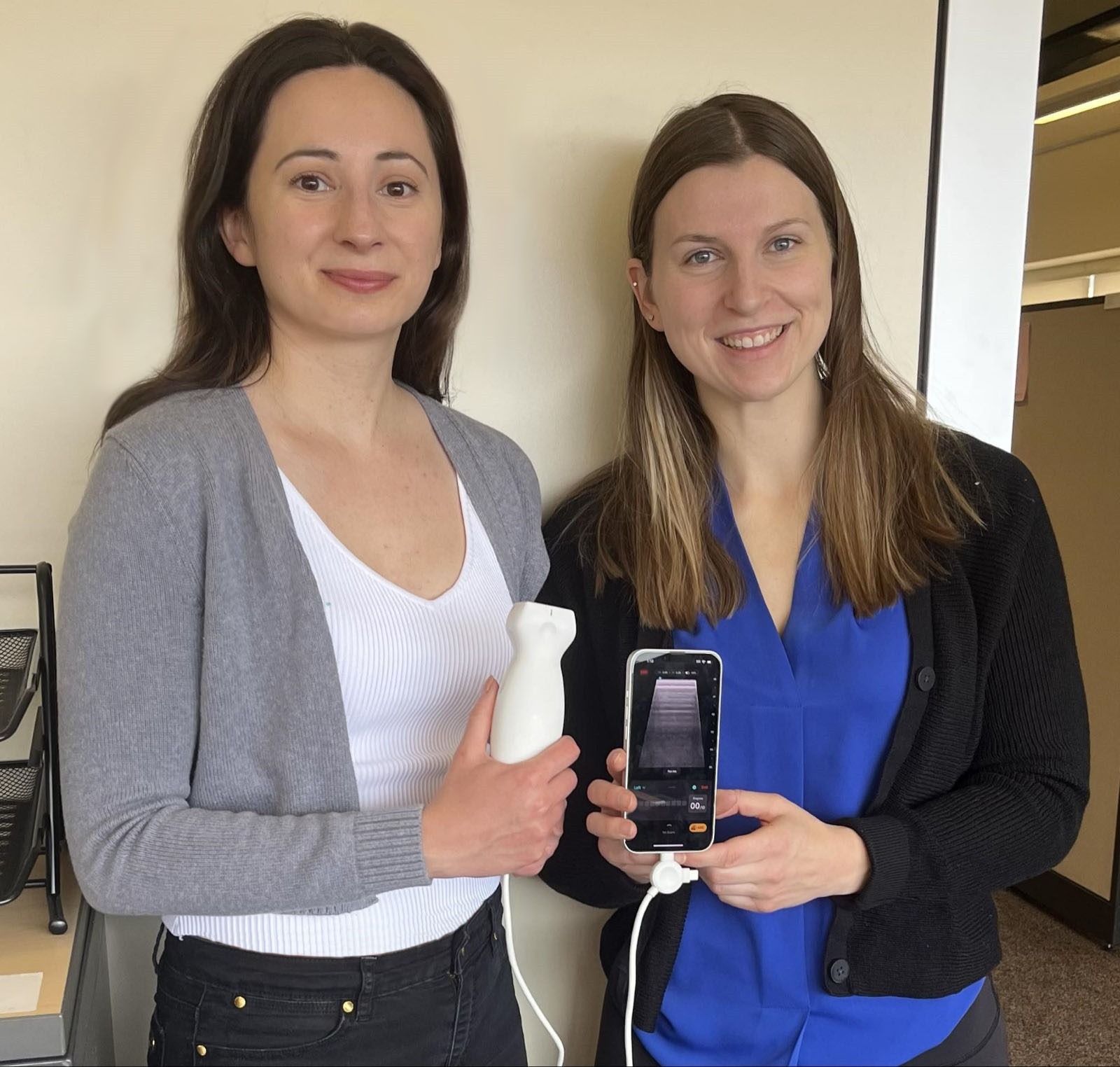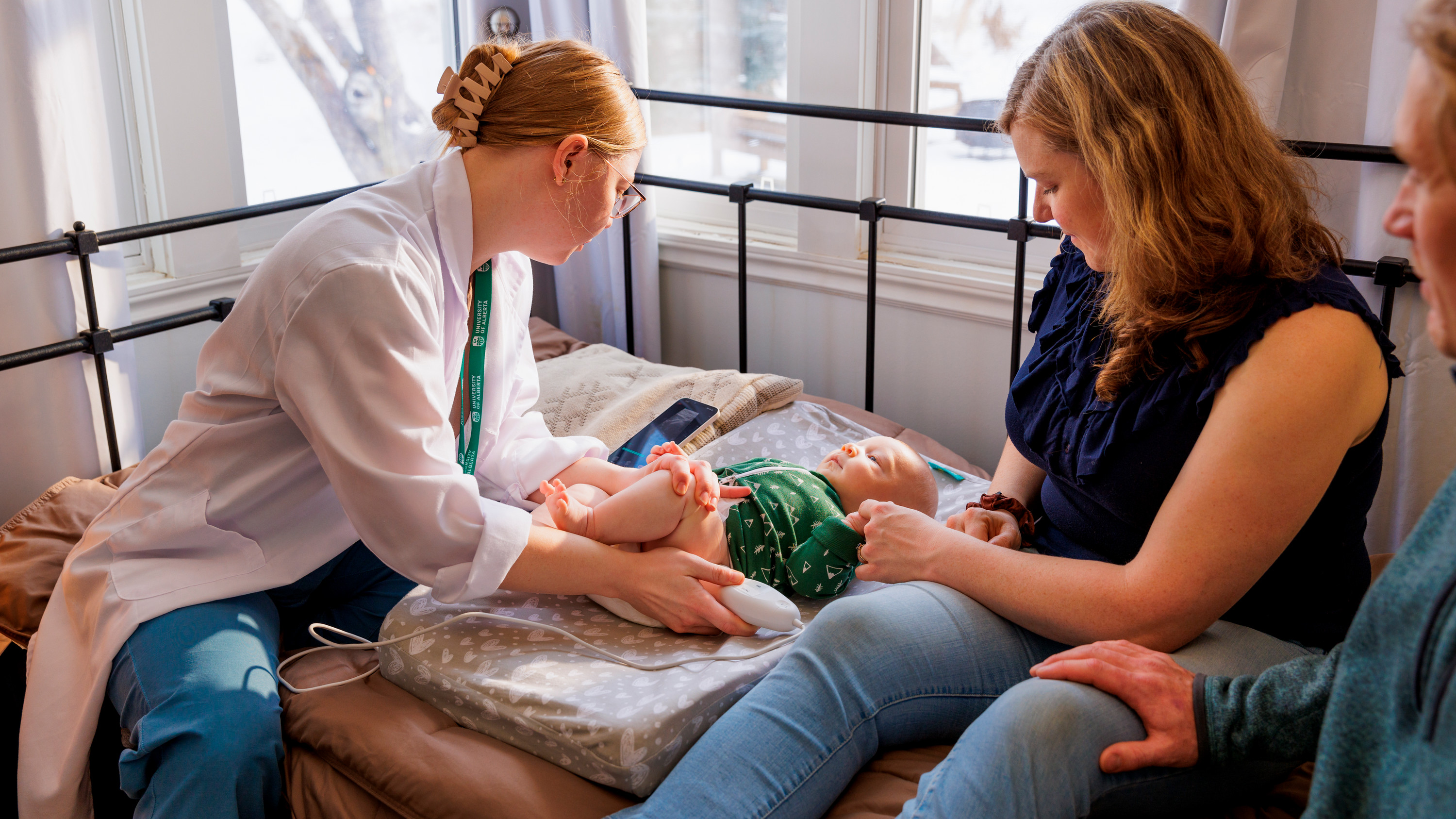U of A medical students to showcase AI-enhanced portable ultrasound technology
Shirley Wilfong-Pritchard - 2 April 2024

Second-year medical students Dana Moon and Meagan Eckel with portable ultrasound device.
Second-year University of Alberta medical students Meagan Eckel and Dana Moon will be giving a presentation and demonstration of a new scanning tool for early detection of developmental dysplasia of the hip (DDH) in infants at the upcoming Rural and Remote Medicine Conference, hosted here in Edmonton by the Society of Rural Physicians of Canada.
The presentation stems from research they participated in at the Northern Institute for Deep Learning in Ultrasound (NIDUS) at the U of A last summer. The principal investigator at NIDUS is Jacob Jaremko, U of A professor in the Department of Radiology & Diagnostic Imaging, Canadian Institute for Advanced Research Canada AI Chair and fellow of the Alberta Machine Intelligence Institute. He is also a practicing pediatric and musculoskeletal radiologist and co-founder of two startup companies.
This innovative designed-in-Alberta technology uses a portable ultrasound — requiring only a mobile phone or tablet — and AI. It can potentially capture 100 per cent of DDH cases, compared to the current detection method — manipulating an infant’s legs during a physical examination — that is just 20 to 25 per cent effective. And it takes only an hour to learn how to use it.
This quick and easy, reliable way to screen for DDH in infants will allow rural and remote health-care providers to diagnose and treat for the condition earlier, which can mean avoiding surgery, lifelong complications and the need for specialized services, which are not locally available.
“The presentation is a great way to showcase and spread the word about this new screening method,” says Moon. “I feel very lucky to participate in research that immediately helps patients by scanning them and has a long-term impact by introducing and supporting new technologies in communities.”
Eckel and Moon note that many families living remotely do not have access to specialized services and there is also a higher rate of DDH in Indigenous populations who often have more barriers to accessing care.
“I feel very fortunate to be able to give a talk to rural health-care professionals from across the country, especially as the content has the opportunity to impact patient care by reducing barriers,” says Eckel, who is from Fort McMurray and interested in bringing an innovative service to rural and remote communities, including her hometown. After obtaining her MD, Eckel plans to return to Fort McMurray. “We have been through a lot together, and this has created a tight community that cares for one another. I want to go back and serve my community.”
Before medical school, Moon, who has an MSc in chemical engineering, worked as an automation engineer and became very passionate about working with complex technologies. Then after completing her MBA, she focused on how organizations can adopt new technologies into their practice.
“I am definitely driven to utilize new technologies,” says Moon. “I loved engineering, but I felt like having an MD would allow me to interact more with people and improve lives directly. And I love working with babies and families, solving complex problems and driving large-scale changes.”
 The portable ultrasound technology can be used on rural home visits.
The portable ultrasound technology can be used on rural home visits.
The students have scanned more than 1,000 infants so far. Part of their project involves working with individual service sites to develop creative solutions and a proposal for health regions to support the program. They are currently working on a micro-certification program for health-care workers and local community members to use AI-enhanced portable ultrasound to detect DDH in infants.
The new tool is also being used to diagnose wrist and elbow fractures and rotator cuff tears, and in cardiac echo ultrasound projects. “Handheld ultrasound enhanced by AI can examine almost any part of the body,” says Jaremko, “and could be the 21st-century stethoscope.”
Related: